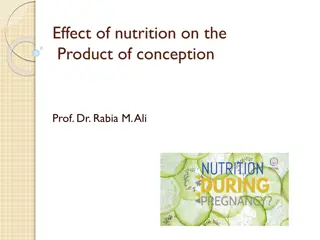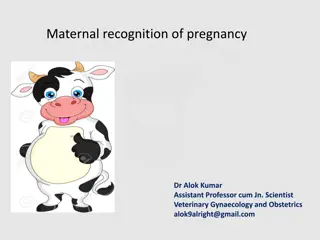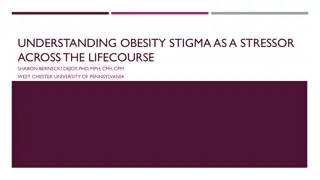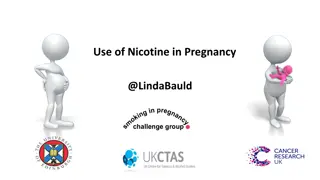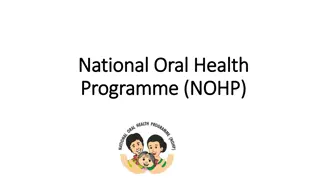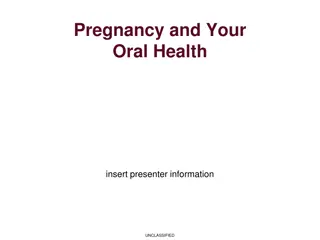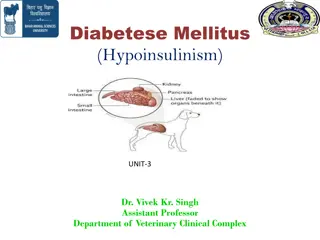Oral Hypoglycemic Agents in Pregnancy: Risks and Benefits
Gestational Diabetes Mellitus poses risks to both the mother and the baby. The use of Oral Hypoglycemic Agents (OHAs) in pregnancy is an emerging option, offering potential advantages over insulin but raising concerns about fetal anomalies, neonatal hypoglycemia, and pre-eclampsia. Evidence suggests that first-generation sulphonylureas may be associated with congenital malformations in mice, highlighting the importance of careful consideration when choosing medications for gestational diabetes management.
Download Presentation

Please find below an Image/Link to download the presentation.
The content on the website is provided AS IS for your information and personal use only. It may not be sold, licensed, or shared on other websites without obtaining consent from the author.If you encounter any issues during the download, it is possible that the publisher has removed the file from their server.
You are allowed to download the files provided on this website for personal or commercial use, subject to the condition that they are used lawfully. All files are the property of their respective owners.
The content on the website is provided AS IS for your information and personal use only. It may not be sold, licensed, or shared on other websites without obtaining consent from the author.
E N D
Presentation Transcript
Oral Hypoglycemic Agents in Pregnancy H. Delshad MD Endocrinologist Research Institute for Endocrine Sciences
Gestational Diabetes Mellitus Congenital anomalies : Non-diabetic women : 2% to 3% Uncontrolled DM in pregnancy : 7% to 9% HAPO : Hyperglycemia below diagnostic levels for diabetes is similarly associated with adverse pregnancy outcomes Excellent blood glucose control results in improved perinatal outcomes
Gestational Diabetes Mellitus Lifestyle , diet and, when indicated, insulin, clearly improve outcomes in GDM Historically, insulin has been the therapeutic agent of choice Whilst effective, insulin has several disadvantages: The need for injection The risk of hypoglycemia Excessive weight gain Costs
Gestational Diabetes Mellitus A safe and effective oral agent would offer advantages over insulin and may well prove more acceptable to patients The primary risks of all medications in pregnancy are affected by the trans-placental passage, associated with : Fetal anomalies Potential for maternal adverse effects Safety of the medications during breastfeeding
Gestational Diabetes Mellitus The use of OHAs has become an attractive option in pregnancy Major concerns regarding the use of OHA: Major concerns regarding the use of OHA: Fetal anomalies Neonatal hypoglycemia Development of pre-eclampsia
Evidence for OHAs In Pregnancy
Evidence for OHAs use in pregnancy Smithberg (1963)and Smoak (1993) : First-generation sulphonylureas, such as Tolbutamide and Chlorpropamide, were associated with congenital malformations in mice. 1-Smithberg M, Runner MN. Teratogenic effects of hypoglycemic treatments in inbred strains of mice. Am J Anat 1963;113:479-89. 2- Smoak IW. Embryopathic effects of the oral hypoglycemic agent chlorpropamide in cultured mouse embryos. Am J Obstet Gynecol 1993;169:409-14.
Evidence for OHAs use in pregnancy Denno and Sadler (1994 ) : Phenformin was embryotoxic in rats, and Metformin was associated with a delay in neural tube closure and reduced yolk sac protein values. Denno KM, Sadler TW. Effects of the biguanide class of oral hypoglycemic agents on mouse embryogenesis. Teratology 1994;49:260-66.
Evidence for OHAs use in pregnancy There are also case reports of congenital malformations associated with the use of, or exposure to, OHAs in human pregnancy. Larsson Y, Sterky G. Possible teratogenic effect of tolbutamide in a pregnant prediabetic. Lancet 1960;2:1424-6. Campbell GD. Chlorpropamide and foetal damage. BMJ 1963;1:59-60.
Evidence for OHAs use in pregnancy Zucker and Simon ( 1968 ) : Tolbutamide and Chlorpropamide cause profound and prolonged hyperinsulinaemic hypoglycaemia among neonates born to women who took these drugs during pregnancy. Cord-serum concentrations of chlorpropamide was similar to those in maternal serum. The half-life of the drug in infants was similar to that in their mothers. Zucker P, Simon G. Prolonged symptomatic neonatal hypoglycemia associated with maternal chlorpropamide therapy. Pediatrics 1968;42:824-5.
Evidence for OHAs use in pregnancy RCT , Notelovitz (1971) : 208 subjects Tolbutamide Diet Insulin Chlorpropamide No significant differences in terms of: Perinatal mortality & Congenital anomalies Notelovitz M. Sulphonylurea therapy in the treatment of the pregnant diabetic. S Afr Med J 1971;45:226-9.
Evidence for OHAs use in pregnancy Coetzee EJ , Jackson WP ( 1980 ) : Pregnancy in established NIDDM A five-and-a-half year study at Groote Schuur Hospital. Glibenclamide and Metformin appear to be safe drugs during pregnancy when properly used. S Afr Med J. 1980 Nov 15;58(20):795-802
Evidence for OHAs use in pregnancy A cohort study : 118 diabetic pregnant women Metformin n=50 Sulfonylurea n=68 32% Pre-eclampsia ( P< 0.001 ) Perinatal mortality ( P< 0.001 ) 7% 1.3% 11.6% Hellmuth E, Damm P, Molsted-Pedersen L.(University of Copenhagen, Denmark) Oral hypoglycaemic agents in 118 diabetic pregnancies. Diabet Med 2000;17:507-11.
Current Evidences for Most of the more recent studies involving Sulphonylurea use in pregnancy have been done using Glibenclamide
Evidence for SUL use in pregnancy Elliot et al. ( 1991) : Placental transfer of the different Sulphonylureas Tolbutamide Glibenclamide = No significant transport , undetected in cord blood ( 99.8% was bound to protein ) Glipizid = Crossed in small amounts ( significantly higher than glibenclamide ) = Diffused across the placenta freely. Elliot BD, Langer O, Schenker S, Johnson RF. Insignificant transfer of Glyburide occurs across the human placenta. Am J Obstet Gynecol 1991;165:807-12.
Evidence for Glyburide use in pregnancy 404 diabetic pregnant women between 11 and 33 weeks of gestation Glyburide Insulin (RCT) 13 % Large for gestational age 12% 7% Macrosomia (4000 g or more ) 4 % 9 % Hypoglycemia 6 % 8 % Lung complications 6 % 6 % Admitted to a NICU 7 % 2 % Fetal anomalies 2 % Cord-serum insulin concentrations were similar Glyburide was not detected in the cord serum NEngl J Med. 2000 Oct 19;343(16):1134-8. Langer O et al.
Evidence for Glyburide use in pregnancy Kremer Kremer et et al. ( 2004 ) al. ( 2004 ) 73 patients with GDM were treated with Glibenclamide 81% achieved satisfactory glucose control No anomalies were identified in all of the newborn infants Although this was not a RCT and the number of subjects was quite small, it supports the findings of Langer study Kremer CJ, Duff P. Glyburide for the treatment of gestational diabetes. Am J Obstet Gynecol 2004;190:1438-9.
Transfer of Glyburide and Glipizide into breast milk The exposure of infants to second-generation Sulfonylureas ( Glipizide, Glyburide) through breast milk is expected to be minimal, based on the limited data available. Feig DS et al. Transfer of glyburide and glipizide into breast milk. Diabetes Care. 2005 Aug;28(8):1851-5. Glatstein MM et al. Use of hypoglycemic drugs during lactation. Can Fam Physician. 2009 Apr;55(4):371-3.
Evidence for Metformin use in pregnancy The use of Metformin in pregnancy has been quite controversial with early reports of adverse effects in those exposed to this drug. Denno KM, Sadler TW. Effects of the biguanide class of oral hypoglycemic agents on mouse embryogenesis. Teratology 1994;49:260-66. Hellmuth E, Damm P, Molsted-Pedersen L. Oral hypoglycaemic agents in 118 diabetic pregnancies. Diabet Med 2000;17:507-11.
Evidence for Metformin use in pregnancy Coetzee et al. 1979 ( South Africa ) : 33 Metformin-treated pregnant women Infant morbidity was low Mortality rates were not higher in the Metformin-treated patients compared to insulin-treated patients (61/1000 vs 105/1000). Coetzee et al. 1980 ( South Africa ) : 171 pregnant women with T2DM The overall perinatal mortality was definitely lower in the Metformin-treated group compared to the untreated group (42/1000 vs 364/1000). Coetzee EJ, Jackson WP. Metformin in management of pregnant insulin independent diabetics. Diabetologia 1979;16:241-5. Coetzee EJ, Jackson WP. Pregnancy in established insulin independent diabetics. A five-and-a-half year study at Groote Schuur Hospital. S Afr Med J 1980;58:795-802.
Evidence for Metformin use in pregnancy With the advent of Metformin use in the treatment of women with PCOD, it is believed that decreasing insulin resistance with Metformin during pregnancy would reduce the rate of early pregnancy loss. All of the delivered neonates were normal with appropriate size for gestational age. Jakubowicz DJ, Iuorno MJ, Jakubowicz S, Roberts KA, Nestler JE. Effects of metformin on early pregnancy loss in the polycystic ovary syndrome. J Clin Endocrinol Metab 2002;87:524-9.
Evidence for Metformin use in pregnancy Glueck CJ et al. Metformin therapy throughout pregnancy reduces the development of gestational diabetes in women with polycystic ovary syndrome. Fertil Steril. 2002 Mar;77(3):520-5. Glueck CJ et al. Metformin is not associated with pre-eclampsia in pregnancy in women with PCOS, and appears to be safe for mother and fetus. Diabet Med. 2004 Aug;21(8):829-36. Glueck CJ et al. Height, weight, and motor-social development during the first 18 months of life in 126 infants born to 109 mothers with polycystic ovary syndrome who conceived on and continued metformin through pregnancy. Metformin reduced development of GD, was not teratogenic and did not adversely affect birth length and weight, growth or motor-social development in the first 18 months of life. Hum Reprod. 2004 Jun;19(6):1323-30. Epub 2004 Apr 29.
Evidence for Metformin use in pregnancy Metformin has been documented in several trials in women with PCOS : Is safe for use in pregnancy The incidence of early pregnancy loss The development of gestational diabetes Insulin levels and insulin resistance A large prospective RCT called Metformin in Gestational diabetes (MiG) comparing the use of Metformin and insulin in gestational diabetes provided us with a significant basis to decide use Metformin in gestational diabetes.
n=751 Insulin n=378 Metformin n=373 Women with GDM 20 to 33 weeks 10 Hospital New Zealand , Australia primary outcomes: Neonatal hypoglycemia Respiratory distress Need for phototherapy Birth trauma 5-minute Apgar score < 7 Prematurity 32.0 % 32.2 % RR= 0.99 ; 95% CI : 0.80 to 1.23 Secondary outcomes: Neonatal anthropometric measurements Maternal glycemic control Maternal hypertensive complications Postpartum glucose tolerance 76.6 % Acceptability of treatment 27.2 %
Evidence for Metformin use in pregnancy MiG Trial : Conclusions In women with GDM, Metformin (alone or with supplemental insulin) is not associated with increased perinatal complications as compared with insulin. The women preferred Metformin to Insulin treatment. Rowan JA, Hague WM, Gao W, Battin MR, Moore MP; MiG Trial Investigators. Metformin versus insulin for the treatment of gestational diabetes. N Engl J Med. 2008 May 8;358(19):2003-15
Current evidence for OHAs use in pregnancy Nicholson W et al. ( 2009 ) Department of Gynecology and Obstetrics, Johns Hopkins A systematic review : A systematic review : Benefits and risks of oral diabetes agents compared with insulin in women with GDM 4 RCT (n=1,229) and 5 observational studies (n=831 ) In these trials Insulin was compared to Glyburide; Acarbose; and Metformin. Outcomes : glycemic control, infant birth weight, neonatal hypoglycemia, and congenital anomalies. No substantial maternal or neonatal outcome differences were found with the use of Glyburide or Metformin compared with use of Insulin in women with GDM Obstet Gynecol. 2009 Jan;113(1):193-205.
Potential effects of Metformin on growth of the children Janet A. Rowan et al. ( MiG Trial investigators) : Metformin in Gestational Diabetes The Offspring Follow-Up ( MiG TOFU ): Body Composition at 2 Years of Age Diabetes Care. 2011 ; 34(10) : 2279-2284 The aim of this study at 2 years of age was to compare body composition in children of women who participated in the MiG trial.
n=751 Metformin n=373 Insulin n=378 Women with GDM 20 to 33 weeks 10 Hospital New Zealand , Australia 2 years follow-up planned at three sites 323 women and children seen ( 56% ) Anthropometry n = 154 Bioimpedance n = 103 DEXA n = 57 Anthropometry n = 164 Bioimpedance n = 118 DEXA n = 57 Offspring followed up from the MiG trial
Metformin n=154 Insulin n=164 n=323 Women & children 2 years follow-up 17.2 1.5 cm Mid- upper arm circumference 16.7 1.5 cm ( P= 0.002 ) 6.3 1.9 mm Subscapular skinfolds 6.0 1.7 mm ( P = 0.02 ) 6.03 1.9 mm Biceps skinfolds 5.6 1.7 mm ( P = 0.04 ) Total fat mass and percentage body fat were not different Whether this will translate to a more insulin-sensitive pattern of growth requires further examination. The findings are reassuring for clinicians who are using Metformin during pregnancy.
The last evidence for Metformin use in pregnancy Preeti Gandhi et al. Department of Ob. & Gy. , Sheffield Teaching Hospital , UK Eur J Obstet Gynecol ( 2011 ) Rertrospective study 592 women with GDM Between Jan. 2008 to June 2010 Lifestyle n = 299 Lifestyle + Metformin n = 293 Supplementary insulin (21%) Supplementary insulin(37%) 8.2 % Macrosomia 14.3 % 14.8 % Birth weight > 90th centile 23.7 % No serious maternal or neonatal adverse events were observed with the use of Metformin
GDM FBS < 95 mg/ dl RBS < 120 mg/ dl HbA1c < 6.5 % FBS > 140 mg/ dl RBS >180 mg/ dl HbA1c < 8.0 % FBS : 95 - 140 mg/ dl RBS : 120 - 180 mg/ dl HbA1c : 6.5 % - 8.0 % Glibenclamide And/or Metformin Medical Nutrition Insulin Treatment plan for GDM
Rosiglitazone Rosiglitazone has not been recommended for use in pregnant women because it has been shown that treatment with the drug during mid to late gestation was associated with foetal death and growth retardation in animal models. It is classified as Category C by the Food and Drug Authority (FDA) for use in pregnancy, which means the risk of adverse outcomes cannot be ruled out. There are 2 reported cases of rosiglitazone exposure during pregnancy : The first patient was a diabetic and hypertensive woman who took 4 mg/day of rosiglitazone for the first 7 weeks of gestation when she was not aware that she was pregnant. Her treatment was changed to insulin when the pregnancy was confirmed and she gave birth to a normal healthy infant at the 36th week of gestation. . Yaris F, Yaris E, Kadioglu M, Ulku C, Kesim M, Kalyoncu NI. Normal pregnancy outcome following inadvertent exposure to rosiglitazone, gliclazide, and atorvastatin in a diabetic and hypertensive woman. Reprod Toxicol 2004;18:619-21.
Rosiglitazone The second patient was a multigravid, diabetic woman who had been managed on diet and exercise alone, and had not received any drug therapy until the 13th week of her sixth pregnancy. She was started on rosiglitazone 4 mg/day from the 13th to the 17th week of gestation, during which she was discovered to be pregnant. Rosiglitazone was stopped and insulin was initiated. She delivered a healthy baby boy without any malformations on the 37th week of gestation. Although these 2 reports did not show any adverse effect from the brief exposure to rosiglitazone, it would be difficult to make any conclusions regarding the safety of its use in pregnancy at the moment Kalyoncu NI, Yaris F, Ulku C, Kadioglu M, Kesim M, Unsal M, et al. A case of rosiglitazone exposure in the second trimester of pregnancy. Reprod Toxicol 2005;19:563-4.
Rosiglitazone A study on the placental transfer of rosiglitazone in the first trimester of pregnancy was recently reported by Chan et al. In this study, rosiglitazone was given to 31 pregnant women between the 8th to 12th week of gestation who were undergoing surgical termination of their pregnancy. Rosiglitazone was detected in 19 foetal samples (61.3%). This shows that there is a high risk of placental transfer and foetal exposure to the drug. Chan LY, Yeung JH, Lau TK. Placental transfer of rosiglitazone in the first trimester of human pregnancy. Fertil Steril 2005;83: 955-8.
Acarbose In a small study by Zarate et al. Six pregnant women with moderately elevated levels of fasting and postprandial blood glucose were treated with acarbose, after which, the fasting and postprandial glucose levels normalized. The pregnancies were uneventful and the newborn babies were normal. Although this study shows promising results, it is still a very early and small study on acarbose use in pregnancy, and therefore, no plausible and definitive conclusions can be drawn from it in terms of the safety and efficacy of acarbose use in gestational diabetes Zarate A, et al. Effectiveness of acarbose in the control of glucose tolerance worsening in pregnancy. Ginecol Obstet Mex 2000;68:42-5.




